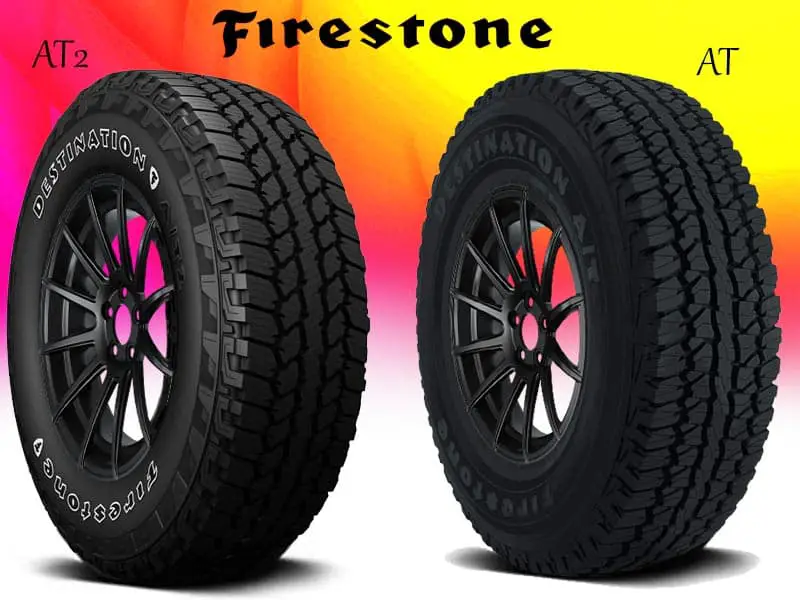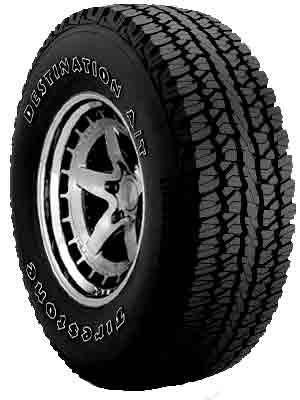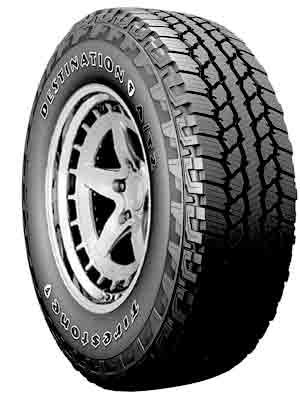Firestone Destination AT Vs AT2: Due to its open tread design, the Firestone AT2 tire provides slightly superior off-road traction as compared to AT.
The AT2 tire features more built strength and a more aggressive design that gives it an edge for exploring off-road.

Examine the treads on these tires closely. They hold the key to knowing which to choose. In fact if you visit my "tread design" page, picking the right tire would never bother you.
The Destination AT on the other side, is best suited for on-road because of its dense tread design.
Table of Contents
Comparing Tread Pattern
Firestone Destination A/T

Firestone Destination A/T2


Vs

The tread pattern on the Firestone Destination AT is designed to give excellent on-road traction as well as somewhat decent off-road performance.
It has a symmetrical tread pattern with a continuous core rib surrounded by distinct tread blocks that are non-aggressive.
The central rib provides extra grip when driving on the road. It has narrow grooves and fewer sipes than its counterpart, which reduces wet traction.
The grooves of AT tires are narrow; hence, they limit traction in mud, soft snow, and gravel. Because of its increased contact patch and deep sipes, the tire performs very well on ice, allowing it to firmly grip the icy surfaces.
It utilizes a revolutionary compound known as “Long Link Carbon,” which is a stronger compound that provides additional resistance to treadwear abrasion, enhancing the durability of tires and mileage.
Its enhanced build quality ultimately lacks the toughness and resistance as compared to AT2.
Because of the smaller void ratio, it has better noise-canceling capabilities, but this also reduces its ability to move smoothly on uneven surfaces.
The Firestone Destination AT2 seems to be an aggressive symmetrical computer-optimized design of sparingly positioned tread blocks that provide broad and deep grooves between them, lowering on-road performance.
It has traction edges and many sipes on its tread blocks for enhanced traction on wet roads.
Wide grooves help to eliminate mud, soft snow, and debris efficiently and improve off-road traction.
The wide shoulder shape is useful for mud traction since it allows mud to move over easily.
Because of its shallow sipes and lack of decent contact area, the tire has a poor grip on ice.
It also includes large stone ejectors for improved rock traction.
Off-roading is also made much easier due to the highly optimized shoulder design.
It has higher built strength and resistance to treadwear, which increases its durability and mileage.
It is noisy on the road as compared to AT, but it performs better in off-road driving because of its wider grooves it has a shock-absorbing ability.
On-Road Traction Comparison
Destination AT focuses on stable on-road performance by including a continual rib that increases the contact patch, providing an additional boost to its on-road grip.
This improves dry traction on the road.
Wet traction is fair because of narrow grooves and lesser sipes which avoid hydroplaning but are not optimal for experiencing extreme wet conditions.
The AT2 tread has a smaller contact surface with the road, resulting in less grip and have a longer braking distance.
This harms the tire on-road traction which ranks inferior to the AT tire. It performs much better in wet conditions.
Water can easily pass between the wider grooves and numerous sipes, making it a better choice for driving in wet situations.
Off-Road
Mud Terrain
In comparison to AT2, the AT has narrow grooves that can throwback mud and navigate muddy terrain, but it is not recommended in heavy mud because the narrow grooves are not well suited to tackle heavy mud efficiently.
The heavy mud will fill the grooves, causing the tire to lose grip and slip.
The AT2’s wider grooves enable for better vehicle navigation through mud, as they can quickly clear mud by thrashing it backwards, therefore pushing the tire forward.
The AT2 tire has an open shoulder design which helps in mud traction by allowing mud to pass through its stud grooves and wide shoulder, resulting in a more efficient tire on mud.
Snow Terrain
The AT, on the other hand, suffers in soft snow because its grooves are too narrow to efficiently grip soft snow, and the tire may be filled with snow, making it useless.
The ice traction is significantly superior due to a larger contact patch and deeper sipes which provide excellent grip and allow the car to move confidently on ice.
The AT2 has wider grooves that provide for better traction in soft snow by effectively gripping and throwing back the soft snow.
However, because of the less contact area and shallower sipes. the traction on ice is severely reduced, resulting in tire skidding on slippery icy roads.
Rock Terrain
AT tire has small stone ejectors that are ineffective in comparison to its rival.
They aren’t able to eject all the pebbles/rocks from the grooves, creating the risk of pebbles and stones penetrating the tire.
Due to its inability to properly withstand the extreme conditions offered by the rocky environment, the tire’s dependency on rocks is further reduced.
Bolder stone ejectors enhance the performance of AT2 on rocks by effectively preventing stones or pebbles from getting trapped inside grooves since they can drill through them.
The tire build quality protects it from damage such as cutting and chipping while also allowing the vehicle to confidently navigate over rocks.
On challenging angles of approach on rocks, the larger grooves provide a strong grip.
Durability and Treadwear Differences
Due to a larger contact patch with the ground AT causes more friction, therefore, it has a higher rolling resistance. Since more effort is required to keep the tire moving, it will have a direct impact on its treadwear, as higher rolling resistance increases treadwear.
It has a long link carbon compound to improve tread strength, however, it is still less durable than AT2. Its durability is further harmed by the inferior build quality, which reduces tire tread wear resistance.
All these issues contribute to the loss of the tire’s average mileage, making it lower compared to its competitors.
AT2 has a smaller contact patch which allows less rolling resistance.
Less rolling resistance means less treadwear of the tire, which increases its durability and grants long-lasting life. Its stronger build quality reduces treadwear which makes the tire more resilient to tear and wear.
Tear-resistant compound and chips, as well as two steel belts, make the tire more durable and dependable, resulting in better mileage compared to AT.
Which Tire is more comfortable?
AT provides excellent comfort while driving on the road since the narrow grooves produce minimal noise during higher-speed because few particles of air get trapped in its grooves, resulting in only a minor noise.
However, the off-road comfort is significantly reduced, since narrower grooves are unable to absorb the jerk when dealing with difficult terrain which makes the off-road journey terrible.
The AT2 tire has wider grooves as compared to AT, this tire fails to maintain on-road comfort rides since wide grooves produce a lot of noise at high speeds.
This noise is caused by air particles stuck inside the grooves striking its wall back and forth. The wider grooves work as shock absorbers while off-roading which absorbs the effect of jerks on uneven terrain.
This improves the tire off-road comfort by allowing smoother navigation.
To Conclude
- AT2 performs better off-road while AT performs well on-road
- AT2 provides good wet traction.
- Mud, soft snow, and rock performance of AT2 is much improved because of wider grooves.
- On ice, AT is clear winner.
- AT2 has an advantage over AT due to its bold stone ejectors.
- AT2 has higher durability and tread wear resistance.
- AT costs higher compared with its rival.








